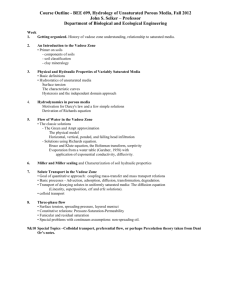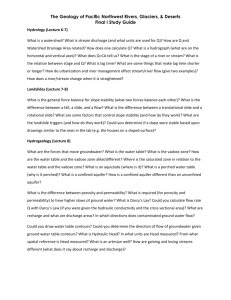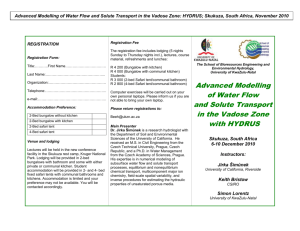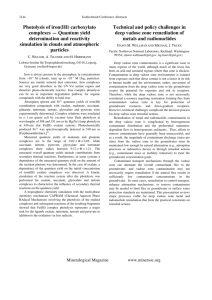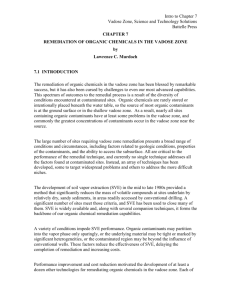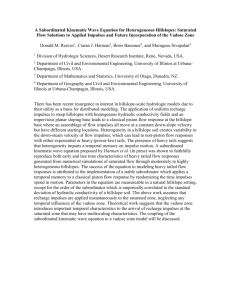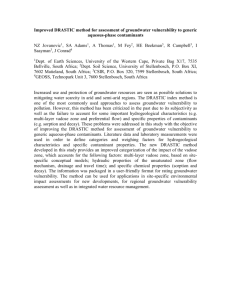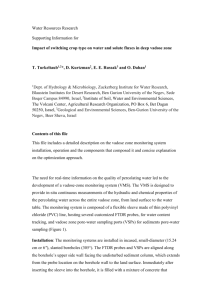Chapter 1 part 1 - preliminaries
advertisement
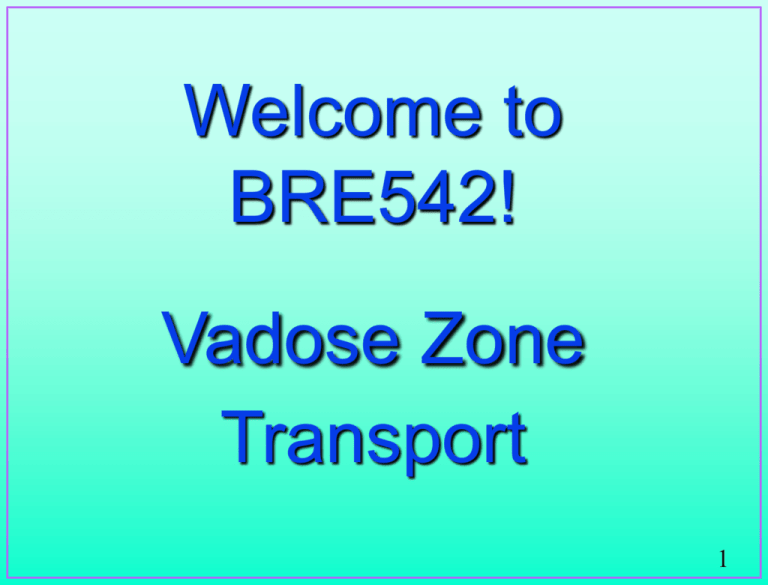
Welcome to BRE542! Vadose Zone Transport 1 Today Introduction to Course Related Texts Definition/importance of Vadose Zone Related areas of study History of Investigation of Vadose Processes Relationship to Saturated Media 2 Logistical Issues BRE 542, Vadose Zone Transport, Fall 2003 Department of Bioengineering John S. Selker Telephone: 541-737-6304 email: selkerj@engr.orst.edu Office hours: MWF 10am-11am, or by appointment Lab help hours: Monday 4:00-4:45 Websites: Vadose kits: http://bre.orst.edu/faculty/selker/vadose_teaching.asp Lectures: http://bre.orst.edu/vzp How the BRE 542 will be run •Three exciting lectures/wk •Numerical simulation project (you don’t need to write code) Homework largely from experiments •Experimental and data-based homework. 3 More Logistics ... Grading • One homework per week given on Monday, due the following Monday by 5 PM. (1/2 grade). • One numerical modeling project (presentation plus 7 page paper; 1/6 of grade). Papers are due Dec 5. See special handout on this component. • 10 min quizzes will be carried out after each of the 4 chapters, announced 1 week in advance (1/6 of grade). • Final exam (1/6th of grade). A closed book exam which covers the most significant concepts presented in the course. 4 Idiosyncrasies in the professor (the fine print) Interpretation: 25% of the score of each problem is given for interpretation of the result (qualitative) Calculations: Even if you have the right number written down for the answer, you are only 75% of the way done unless you have thought about what the results mean. Late homework is not accepted unless prior arrangements have been made, as homework is often handed back on the next class meeting. The Rules: Group work: Wonderful, but must list the group of helpers, and may not simply copy the work of others. Writing: must be your own work, unless properly cited. If in doubt, ask me. Plagiarism of written work will result in failing the course. 5 Course Outline 1. An Introduction to the Vadose Zone (4 lect.) • History of investigation • Modern concerns • Relationship to saturated media • Primer on soils 2. Physical & Hydraulic Properties Unsaturated Media (8 lect) • Basic definitions • Hydrostatics (Surface tension;Characteristic curves; Hysteresis) • Hydrodynamics in porous media (Darcy's law; Richards equation) 3. Flow of Water in the Vadose Zone (10 lect.) • The classic solutions (Green & Ampt; Evaporation from Water Table). • Solution for capillary barriers • Miller and Miller scaling • Characterization of soil hydraulic properties 6 Course Outline Continued 4. Solute Transport in the Vadose Zone (5 lect.) •Processes - Advection, adsorption, diffusion, degradation. • Advective Diffusive Equation (Linearity, superposition, solutions). 5. Three-phase flow (2 lect.) • Surface tension, spreading pressure, layered menisci • Constitutive relations: Pressure-Saturation-Permeability • Funicular and residual saturation • Special problems with continuum assumptions: nonspreading oil. 6. Special Processes (2 lect.) • Macropore Flow • Fingered Flow • Biological considerations 7 The Numerical Component of BRE542 Software Description and Access The software is called HYDRUS-2D Developed by the staff of the US salinity lab in riverside CA. Windows based modules with excellent graphical interface. The users manual is very technical 4:00-4:45 PM help sessions Gilmore annex on Mondays. The computer in the upstairs of the annex is set up with new HP workstations – they rip! You may use the computers on a first come first served basis at other unscheduled times. No machines should be left running over night in order to maintain access for other students. 8 The Numerical Component of BRE542 1. Learning the interface A. B. Clicking through the menus and printing results Setting up a problem from scratch. 2. Running a simple problem Draining a profile from saturation to hydrostatic. 3. Project Rules for numerical homework Do all the key strokes for your problem with your own hands, but may talk to others and watch others do their problems as much as you like. Start a problem using the files indicated in the homework (either ones prepared by me, or new files). Only you can enter data in your problem. If you want help from a friend, they can show you by going through operations on their files. 9 ¡El Proyecto! Project is 1/6 of the grade for the course. Phase 1. Defining the problem. a. Due October 3 (15%). 1 or 2 page statement of problem importance, boundary conditions, and expected outcome. b. Due October 13 (15%). Layout of problem in HYDRUS-2D. Define in detail the full problem to be solved Phase 2. Initial simulation results Oct 31 (20%). Write up (1-3 pg text plus figures). Phase 3. Presentations. November 24 and 25 (25%). 7:00-9:30 evening donut and coffee evening sessions of 12 minute presentations. Must come to both sessions. Phase 4. Final submission Dec 5. <10pgs + figures. 10 Drivers, start your engines! 11 Disciplinary Context Related Texts Definition/importance of Vadose Zone Related areas of study 12 HISTORY OF INVESTIGATION It’s worthwhile to understand the historical context of the study of unsaturated flow: A young field with ongoing conceptual development Provides a preview of the topics covered in the course 13 Evidence of ancient operational understanding of hydrology Ancient qanats of Aden Marib dam in Yemen built in 500 b.c. and lasting to the beginning of alternate routes through the orient around 500 a.d. 600 meter face supporting agriculture for 100,000 people. 600 a.d. Sri Lanka builds a network of irrigation works that survive to this day. Yet I know of no evidence that the underlying quantitative relationships between soil type, pressure and flow were understood. 14 Review: First quantitative understanding of saturated flow Darcy 1856 study of the aquifers under Dijon; Introduced the concept of potential flow Water moves in direct proportion to: the gradient of potential energy the permeability of the media 15 First quantitative application to unsaturated flow 1870’s Bousinesq extended Darcy’s law with two approximations (DupiutForcheimer) to deal with drainage and filling of media. “Free water surface” problems. Useful solutions for dikes land drainage, etc. (all as a footnote in his book) Bousinesq Bousinesq equation is strongly nonlinear: much tougher to solve! 16 Rigorous foundation for Darcy’s Law First encyclopedic source of practical solutions based on pore-scale analysis 1899 Slichter “Theory of Flow Through Porous Media” Exact solutions for multiple pumped wells Basis of aquifer testing. 17 Slichter – some of his figures 18 Extension of Darcy’s Law to Unsaturated Conditions 1907 Buckingham (of Buckingham-pi fame) Darcy for steady flow with: Conductivity a function of moisture content Potential includes capillary pressures 19 Extension of Darcy’s Law (cont.) Rule: Folks who write equations are remembered for eternity, while the poor work-a-days who solve them are quickly forgotten. d L Exception: Green and Ampt, 1911. Key problem of infiltration. Modeled as a capillary tubes which filled in parallel, from dry to saturation. Still most widely used infiltration model. 20 Time passes...time passes We need a few tools!! Early 1920’s, W. Gardner’s lab develop the tensiometer: direct measurement of the capillary pressure L.A. Richards extended idea to tension plate: measure moisture content as a function of capillary pressure And then... 1931, Richards derived equation for unsaturated flow. (p.s. Richards just died in the last 5 years). 21 Moisture contents depends on history of wetting Haines (1930) wetting proceeds as “jumps” Still largely ignored, but essential to unsaturated flow processes. 22 Time passes ... time passes Turns out that Richards equation is a bear to solve! Depends on three nonlinear variables: q, y, K First big break for R’s Eq. 1952, Klute rewrote Richards equation in terms of moisture content alone diffusion equation (AKA: Fokker-Plank eq.) Klute gave solution to 1-D capillary infiltration 23 Analytical vs. Numerical Since 1952, more analytical solutions have been presented, BUT non-linearity limited to special conditions. What is the use of Analytical results? They let you see the implications of the physical parameters computers allow solution of individual problems: tough to generalize 24 Then things took off! Lots of great stuff in the 50’s and early 60’s 1956: Miller and Miller: relationship of grain size to fluid properties 60 70 12/20 60 20/30 12/20 50 50 20/30 Scaled Potential Matric Potential (cm H2O) 80 30/40 40 40/50 30 20 40 30/40 30 40/50 20 10 10 0 0 0 0.2 0.4 0.6 Degree of Saturation 0.8 1 0 0 .2 0 .4 0 .6 0 .8 1 Degree of Saturation 25 More 50’s and 60’s 1957: Philip start to deal with infiltration (F ill in g hf Pr es su r e) f (Fraction of Moisture Content) 1962: Poulovassilis: independent domain model of hysteresis (finally Haines stuff can be included) hf+h f hf o 0 0 45 he he+h e he (Emptying Pressure) 26 1970’s: limitations of the assumptions Biggar & Nielson (1970) field scale heterogeneity Hill & Parlange (1972) fingered flow Others: macropores Kung (1988): Funnel Flow 27 Relationship to saturated media While the similarity has been very useful, it is a source of many errors Main distinctions in three areas. Capillarity (lateral, upward flow) Heterogeneity into the temporal domain Biochemical activity Diffusion is two orders of magnitude faster Ample oxygen Take-home message: be very careful! 28 Similarities: • Both have governing equations for flow that are linear in the local potential gradient • They share similar constitutive media (with particles ranging from clay to gravel) Differences Issue Conductivity at a point Density Effects Spatial variability Biological and chemical activity Transport mechanisms Vadose Zone A nonlinear function of moisture content. Negligible influence for temperature and solute based changes. Saturated Zone Constant. Temperature and solute based density differences can dominate both static and dynamic disposition. Lognormal distribution Lognormal distribution fixed and a function of moisture in time. content and hence time. Often high in carbon and Typically anoxic with sparse oxygen, leading to rapid carbon: comparatively slow microbial metabolism. microbial activity. Advection 0-10 cm/day Advection 0-100 cm/day Dispersivity 0.5-20 cm Dispersivity 0.5-20 cm Diffusion 0.1-.3 cm2/s Diffusion 0.00002 cm2/s 29 Contemporary Concerns with the Vadose Zone Water conservation (how to use minimum water to irrigate crops) Nutrient storage and transport Pesticide degradation and movement Salinity control Water budget for climatic modeling Bulk petroleum and organic contaminant transport (vapor and liquid): Industrial 30 contamination Example Suppose that 2,000 liters of some nasty liquid spilled on a 10 m2 area above an aquifer that was at a depth of 10 m. How much makes it to the aquifer? 31
